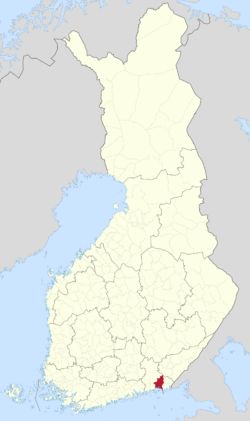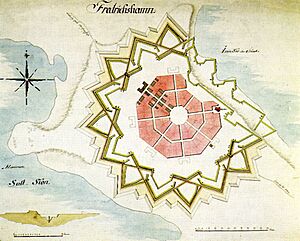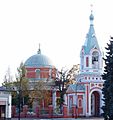Hamina facts for kids
Quick facts for kids
Hamina
Fredrikshamn
|
|||
|---|---|---|---|
|
Town
|
|||
| Haminan kaupunki Fredrikshamns stad |
|||

Clockwise from top-left: St. Mary's Church, the Reserve Officer School, the countryside of Husula neighbourhood, a view from the Sailor Pavilion towards Tervasaari and the historical Town Hall.
|
|||
|
|||

Location of Hamina in Finland
|
|||
| Country | |||
| Region | Kymenlaakso | ||
| Sub-region | Kotka-Hamina | ||
| Charter | 1653 | ||
| Named for | Frederick I of Sweden | ||
| Area
(2018-01-01)
|
|||
| • Total | 1,155.14 km2 (446.00 sq mi) | ||
| • Land | 609.89 km2 (235.48 sq mi) | ||
| • Water | 545.66 km2 (210.68 sq mi) | ||
| Area rank | 138th largest in Finland | ||
| Population
(2023-12-31)
|
|||
| • Total | 19,534 | ||
| • Rank | 58th largest in Finland | ||
| • Density | 32.03/km2 (83.0/sq mi) | ||
| Population by native language | |||
| • Finnish | 91.7% (official) | ||
| • Swedish | 0.3% | ||
| • Others | 8% | ||
| Population by age | |||
| • 0 to 14 | 12.8% | ||
| • 15 to 64 | 57.2% | ||
| • 65 or older | 30% | ||
| Time zone | UTC+02:00 (EET) | ||
| • Summer (DST) | UTC+03:00 (EEST) | ||
| Climate | Dfb | ||
Hamina is a town and municipality in Finland. It is located about 145 kilometers (90 miles) east of Helsinki, the capital city. Hamina is part of the Kymenlaakso region.
As of 31 December 2023, about 19,534 people live in Hamina. The town covers an area of 1,155.14 square kilometres (446.00 sq mi), with some of it being water. The main language spoken in Hamina is Finnish.
Hamina is connected to Helsinki by Highway 7 (E18). It is also home to one of Finland's most important harbors, the Port of Hamina-Kotka. This port is known for handling forest products and cargo going to Russia. Did you know that one of Google's data centers in Europe is also located in Hamina?
Contents
History of Hamina
Early Beginnings and Destruction
The area around Hamina was first mentioned as a municipality called Vehkalahti in 1336. In 1653, a new town was founded near the Vehkalahti church, which is now called St. Mary's Church. This new town was named Vehkalahden Uusikaupunki. Sadly, the town was destroyed in 1712 during the Great Northern War.
Rebuilding and New Name
After the city of Vyborg was lost to Russia in 1721, Fredrikshamn was chosen to replace it as an important trade center. The town was renamed in 1723 to honor King Frederick I of Sweden. The Finnish people living there soon shortened the name to Hamina.
The town was rebuilt between 1722 and 1724. It was designed with a special star-shaped fortress and a circular street plan. This unique design was inspired by old European ideas from the 16th century. Not many towns have a circular street plan like Hamina; one famous example is Palmanova in Italy.
Hamina's Role in Finnish History
In 1743, Hamina became part of Russia after a war. This made the nearby town of Loviisa the next important Swedish trade center in eastern Finland. Hamina became a Russian border town, and its fortress became very important.
A very important agreement, the Treaty of Fredrikshamn, was signed in Hamina in 1809. This treaty meant that Sweden gave Finland to Russia. Finland then became the Grand Duchy of Finland, which was a self-governing part of the Russian Empire. In 1812, Hamina and other areas that Russia had taken earlier were joined with the Grand Duchy.
Military Schools and Modern Times
The Hamina Cadet School was started in 1819 and operated until 1903. Later, in 1920, the Reserve Officer School began using the same buildings. This school still trains reserve officers for the Finnish Army.
In 2003, the municipality of Vehkalahti joined with Hamina. The town's old coat of arms was brought back in 2013.
Main Sights and Attractions
Hamina has many interesting places to visit, showing its long history and unique design.
Historical Buildings and Museums
- Town Hall: This building was first built in 1798. It was later updated in 1840 by a famous architect named Carl Ludvig Engel.
- Town Museum: You can find this museum in a building where King Gustav III of Sweden and Empress Catherine II of Russia met in 1783. It's a great place to learn about the town's past.
- Shopkeeper's Museum: This museum shows what life was like for shopkeepers in the past.
Fortress and Modern Sites
- Hamina Fortress: Built in the 18th century, this is one of Finland's unique star forts. It has six corners, called bastions, named after different towns in Finland. The Central Bastion was added later and is now used for fun cultural events.
- Google Data Center: This is a modern and important site, built in what used to be a large pulp factory.
Churches of Hamina
Hamina is home to several beautiful and historic churches.
- St. Mary's Church: This church, also known as Vehkalahti Church, is the oldest building in the Kymenlaakso region. It was first built in the Middle Ages. After a fire in 1821, it was rebuilt with a neoclassical style, designed by Carl Ludvig Engel. It also has a museum about church life.
- St. John's Church: This church was built between 1841 and 1843. It was also designed by Carl Ludvig Engel in the neoclassical style.
- Church of St. Peter and St. Paul: This is the Orthodox church in Hamina, built in 1837. Its design combines neoclassical and Byzantine styles, created by architect Louis Visconti.
Sports in Hamina
Hamina has a pesäpallo (a Finnish baseball-like sport) club called Haminan Palloilijat. They have teams for both men and women that play in the national league, Superpesis, at Rampart Field.
Sister Cities
Hamina has special connections with other towns around the world. These are called twin towns or sister cities:
Famous People from Hamina
Many notable people have come from Hamina:
- Magnus Enckell (1870–1925), a symbolist painter.
- Simo Häyhä (1905–2002), a farmer and famous military sniper.
- Pelle Miljoona (born 1955), a musician.
- Hugo Simberg (1873–1917), a painter. His birthplace, a house called "Herran Kukkaro", is in Hamina.
- Emilie Mechelin (1838–1917), an opera singer and teacher.
- Leo Mechelin (1839–1914), a professor, statesman, and reformer.
- Keke Rosberg (born 1949), a racing driver.
- Meri Toppelius (1863–1896), an educational theorist.
Images for kids
See also
 In Spanish: Hamina para niños
In Spanish: Hamina para niños









